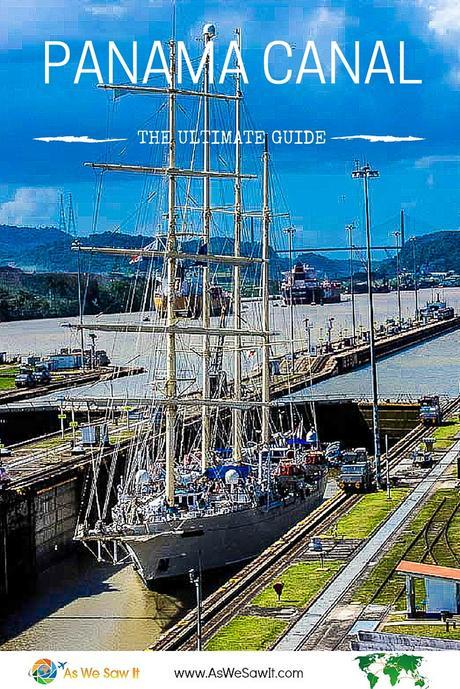Mention Panama and most people will immediately think of its famous canal. It’s no wonder, really, because it’s one of the Seven Wonders of the Modern World and the country’s top attraction. If you’re in Panama City and you want to see it, here’s your definitive guide to visiting the Panama Canal, including the best places to view the ships and what to expect.
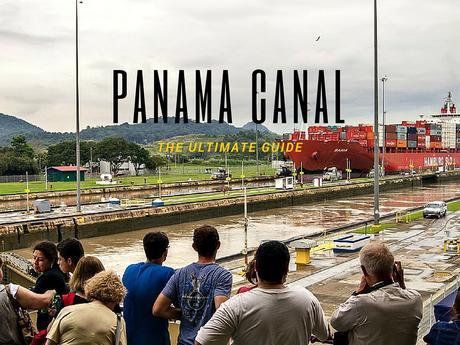
How to see the Panama Canal
Consider: The Panama Canal is 48 miles long. This means that there are plenty of great places to see it. However, if you want to watch a ship pass through its locks, you can only do it at three locations:
- Miraflores Locks – the most visited because it’s closest to Panama City and has a beautiful visitor’s center.
- Pedro Miguel Locks – a single set of locks a few minutes north of Miraflores; it is not set up for visitors.
- Gatun Locks – the three locks that are on the Caribbean side of the canal. They lie near the city of Colón, an hour’s drive from Panama City.
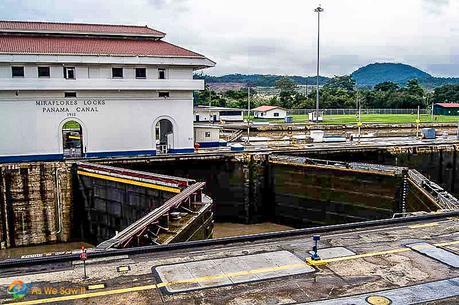
Though its two “lanes” make it look like the ships might be able to go in both directions at the same time, the Culebra Cut makes this impossible. This treacherous area is far too narrow for large ships to pass each other. (This area was the biggest challenge when they built the canal: They had to blast and cut their way through.) So for 12 hours a day ships pass from north to south, and for the other 12 they go from south to north.
Update June 2016: All that is set to change with the massive Canal expansion, due to open any day. This has been the largest project since the canal was first built and will double the waterway’s capacity. Thanks to the new lane of traffic and larger locks, it will be wide enough for even the mega-sized Panamax ships to pass through. Follow the day-by-day progress here, through their own videos, photos and webcams.

Tip: Get a great view of the Panama Canal entrance from the Chinese Monument, located at the Bridge of the Americas’ western end.
Visiting Gatun Locks
If we have the time we like to take our visitors to both Gatun and Miraflores. The canal locks at Gatun aren’t very crowded, whereas Miraflores can be wall-to-wall people. Besides, what you lose from not having a Panama Canal museum to visit, you gain from being practically an arm’s reach away from the ships. There is a small viewing platform and everyone there is extremely helpful.
Update June 2016: After visiting the Gatun Visitors Center (buy the entrance tickets there) head to the new Panama Canal Expansion Observation Center nearby.
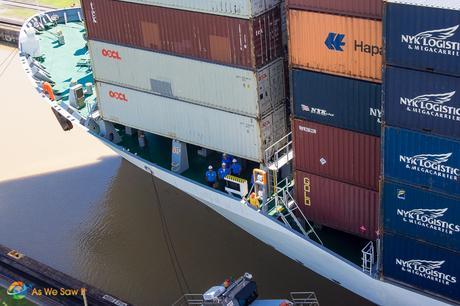
Gatun Locks: You can’t get much closer to ships passing through the Panama Canal than this!
A unique way to see the ships pass through the Panama Canal
After the hour-long drive to Gatun we extend our trip with a drive to Fort San Lorenzo, a UNESCO site which is on the other side of the canal.
Here’s where the fun comes in: To get there, we drive through the Panama Canal.
I have no idea how they came up with the idea, but there is a roadway over the canal, at water level. We exit the parking lot and turn left, stopping at a traffic signal. It seems a bit odd to see a stop light here.
Once the massive, metal gates at Gatun Locks have closed and begun to fill with water, a one-lane metal bridge rotates to create a roadway over the canal. Soon the light turns green, a guard waves us through and we descend the ramp to the bridge. The Caribbean is only a few feet beneath our tires.
The massive doors tower overhead as our car slowly crosses the narrow bridge, so close we might count every rivet. Rivulets of water drip and spew from cracks and crevices around the doors, reminding us that a wall of water lies just beyond. Please stay closed, we plead in our thoughts, and we avert our gazes to the other direction even though we know there’s no risk at all.
There, we see a ship awaiting its turn. It looks monstrous from down here.
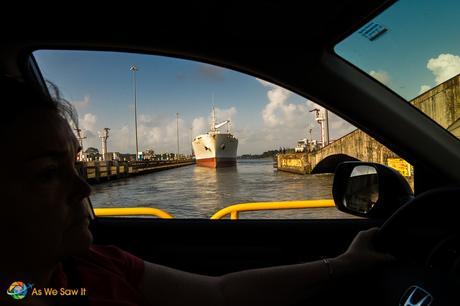
Drive through the Panama Canal? Yes, at Gatun Lakes you drive where the ships travel … and are rewarded with this view.
The drive to San Lorenzo is picturesque, with alternating views of the azure sea and dense rainforest. It is worth the time, but that’s a story for another day. With no other route back we’ll be returning this way later and driving back over that bridge a second time.
Visiting Miraflores Visitor Center
Make time to visit the Miraflores Visitor Center, a fascinating place that will help you understand how the entire canal operates. They have informative films, an interesting museum that even kids will enjoy (fish! bugs!), and viewing platforms where you can watch the ships pass through.
Film showings alternate between Spanish and English, so ask when the next English showing is and plan your schedule around that. If you have any questions, all the staff are bilingual and incredibly helpful and informative.
I still enjoy watching the enormous ships rise skyward as the locks fill with lake water and the 7-foot-thick gates open and close. Sometimes while they do, the ships’ crews and passengers will wave to everyone, and the platform full of people will wave back. It’s a bit too far away for the crew to hear anyone shout “Hola!” or “Bienvenidos!” (welcome) – assuming that they’d understand the words – but a smile and a wave will always express what words can’t.
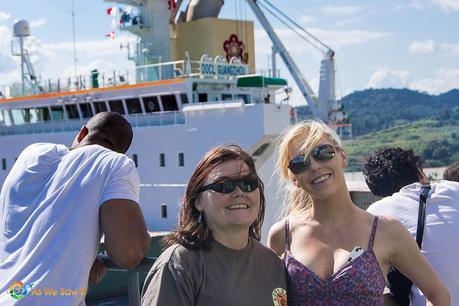

Understanding how the canal operates
I could have a ho-hum, been there-done that attitude but I always enjoy visiting. The Canal has an announcer who narrates details about the current ship that’s passing through – its nationality, size, cargo and other particulars – and explains how the canal system operate. He/she does it bit-by-bit, back and forth between Spanish and English. It’s fun to try to understand the Spanish words.
Some of these ships are so wide that only a few inches separate them from the concrete sides of the locks. Others are small enough that more than one can fit at a time. In either case it’s vitally important to protect the locks from accidental damage, so pleasure boats and small fishing boats usually transit next to a canal tug boat and they just get tied to the tug boat as they go.
A lock master on each side of the locks has ready communication with both the pilot and the control tower for the entire operation.
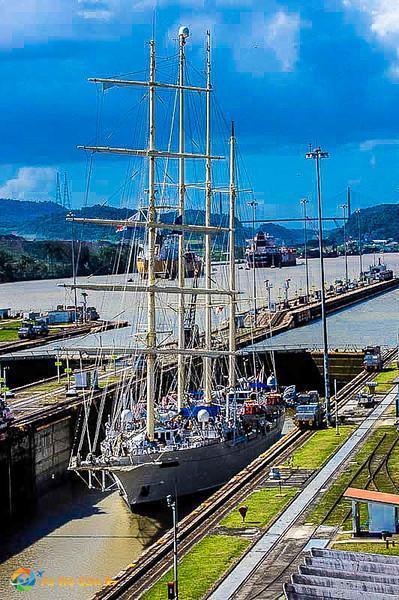
Yes, I said pilot. The ship’s captain is required to yield control of the ship while it’s transiting the canal. There are official Panama Canal pilots who are specially trained to guide ships through safely, mainly because of the Culebra Cut. It is so narrow that only one ship can go through at a time. Imagine what would happen to world trade if a ship\s captain, who’s used to the open sea, misjudged and ran aground there! Ah, well, the pilot gives him a break.
Mini towing locomotives, called mules, will use cables to safely guide the larger ships through. Up to eight towing locomotives and sixteen cables will guide them through the canal. Line handlers are trained to be accurate in getting those wires on board the ship as fast as possible to provide a safe transit.
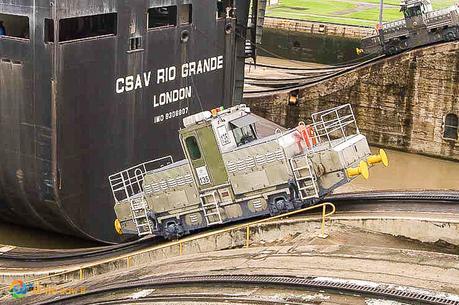
The admission allows access to more than just the viewing platform: The Visitor Center also features:
- an ample, fully equipped theater
- the observation terraces
- two snack bars
- a white tablecloth-type restaurant with panoramic view, and
- the ubiquitous gift shop.
I confess I once succumbed to its lure and bought a cool ceramic Panama Canal tea mug, complete with a lid and basket that holds the tea leaves as they steep….
But I digress.
The Panama Canal History Museum
Even if you’re not normally a history buff, there’s a lot of cool stuff in the museum. The museum has historic pieces, models of ships and construction equipment, a navigation simulator, video presentations, a topographical model of the Panama Canal itself, and objects used in Canal operations.
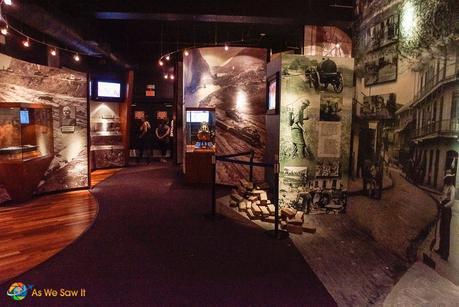 How the four-level exhibit is laid out, floor-by-floor:
How the four-level exhibit is laid out, floor-by-floor:

- The History Hall portrays the background, technological innovations, and sanitary initiatives during the construction of the Canal.
- The Hall of Water: Source of Life – the importance of water, environmental conservation and biodiversity, and protecting the Canal Watershed.
- The Canal in Action – how the Canal operates, Canal improvement, modernization, and maintenance projects. You can also experience being inside one of the lock culverts and pretend you’re piloting a ship through a lock.
- The Canal in the World – the importance of the Canal to world trade, the trade routes it serves, its main users, the various types of vessels that what go through, and what they carry.
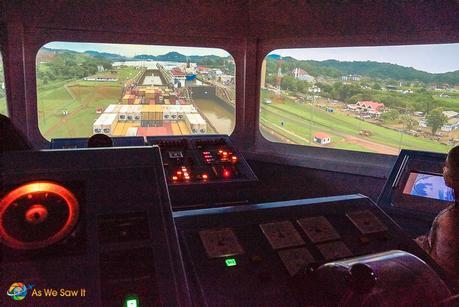
Tips on how to visit the Panama Canal yourself
- It’s easy to get to the Visitor Center by taxi (about $10) (don’t have him wait; you can find another one outside when you’re ready to leave). It’s also a stop on the Hop-on/Hop-off bus route.
- Dress in layers. It can be hot outside on the platforms and cool inside. (Platforms are sheltered from the rain and sun.)
- If you have long hair, you may want to bring a comb or tie it back. It can get windy outside.
- Miraflores Visitor Center is open every day from 9-4:30. Admission is B/.15.00 (B/.10.00 for children between 6 and 12). (Prices in Balboas, currently equal to USD.)
- Expect to pay B/.5.00 to visit Gatun Locks (free for anyone under 12). Open daily from 8:00-4:00, including holidays.
- If you want to eat at the restaurant at Miraflores it’s best to call ahead so you can request a table with a view. You can dine in air conditioned comfort indoors or choose to dine al fresco. (The outdoor balcony has an overhang but it can be breezy.)
- Avoid visiting Miraflores midday (between about 10:30am-2pm). You won’t see any ships in the locks during that time; they’re changing directions.
For additional information on the Panama Canal or to make a reservation at the full-service restaurant, call +507 276-8325 or -8449 or email [email protected]
Here’s a Panama Canal video you might enjoy
Inspired?
Pin this photo and then enjoy the rest of our articles about Panama. There’s so much more to Panama than the Panama Canal, beginning with our list of the top things to see in Panama City. Not all of them are in the guidebooks, so do take a look.
